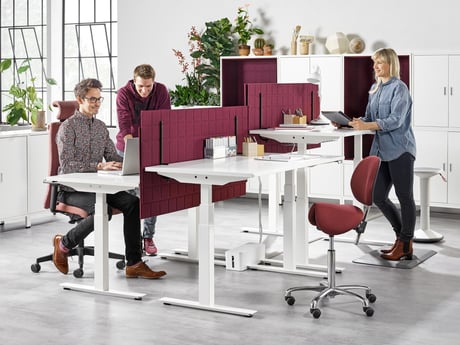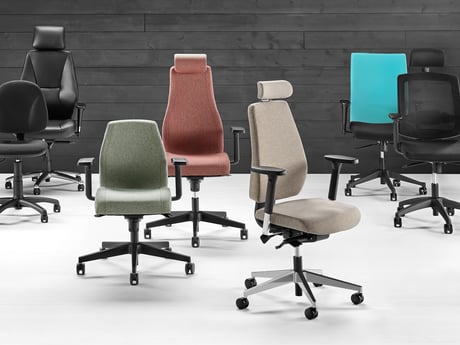
10 Office furniture trends for 2024
Adding a splash of colour to this new vision is none other than Pantone's 2024 Colour of the Year: Peach Fuzz. This warm, inviting hue promises to grace office spaces, from accent walls to cozy chairs, creating a sense of connection and comfort for the modern workforce.
The shift towards flexibility
The world has changed, and for many, the pre-pandemic days may feel like a distant memory. The ripples of the COVID-19 pandemic continue, shaping our norms and perceptions. In response, flexibility has become a defining feature of this new era, characterised by adaptability, inclusivity, and resilience. It prioritises individual well-being and the ability to navigate uncertainties with agility.In essence, flexibility is about adapting to a dynamic and unpredictable environment. It recognises the value of accommodating diverse workstyles, acknowledging that the one-size-fits-all approach no longer aligns with modern life and work.


1. Modular furniture
Our first 2024 trend is modularity, a dynamic force that plays a crucial role in facilitating flexibility. Modular office setups allow for easy reconfiguration of spaces to meet different needs. This adaptability is particularly relevant in the context of changing work dynamics, where employees might alternate between remote and in-office work. Modular furniture, adjustable partitions, and versatile layouts provide the agility needed to create work environments that cater to the evolving preferences and requirements of individuals and teams.
2. Active furniture
Treadmill desks and bike chairs might not be a mainstream trend just yet, but we think they deserve a shout-out. Why? They align with several key themes of 2024: employee well-being, a spirit of innovation, and empowering individual choice.
For employees seeking to prioritise their health and well-being, the idea of battling sedentary lifestyle ills while powering through their workday might hold significant appeal. Active furniture presents a novel approach to this, though challenges like cost, space constraints, and suitability for specific tasks necessitate thoughtful planning before embracing this energetic revolution. Still, it stands as a compelling vision for the future of the workplace, where movement and productivity might one day dance hand-in-hand.
Discover active workspaces

3. Sustainable & eco-friendly designs
Sustainable furniture and environmentally conscious design hold considerable significance in the contemporary workplace, with businesses in the UK placing a growing emphasis on reducing their environmental impact. The adoption of sustainable furniture represents a tangible step towards responsible business practices, aligning with the broader movement towards eco-friendly approaches.In addition to addressing environmental concerns, there is a rising awareness of the positive effects of sustainable designs on employee well-being. Research indicates that exposure to natural elements, often integrated into sustainable designs, can enhance overall health, alleviate stress, and boost cognitive function. This shift towards eco-conscious design is part of a larger trend aimed at fostering healthier and more inspiring workspaces.
Contrary to common assumptions, choosing sustainable furniture also proves to be economically smart. Features such as energy-efficient lighting, the use of low-maintenance materials, and waste minimisation strategies contribute to substantial long-term cost savings. As businesses in the UK increasingly prioritise environmental responsibility and the well-being of their workforce, opting for sustainable furniture emerges as a practical and ethical choice, fostering workplaces that flourish on both ecological and economic fronts.
4. Recycled and upcycled materials
In the context of employee well-being, furniture crafted from recycled or upcycled materials introduces a distinctive aesthetic that can inspire creativity and innovation. The unique character of these materials, often carrying a history or a previous life, adds a layer of authenticity to workspaces, creating environments that resonate with individuals.The trend of using recycled and upcycled materials also offers economic advantages. It aligns with the principles of a circular economy, reducing the need for new raw materials and minimising the environmental impact associated with traditional manufacturing processes.
5. Energy efficient solutions
Fostering a more eco-conscious and comfortable working atmosphere has been a priority for a number of years so, once again in 2024, let’s talk about it!The integration of LED lighting into furniture stands out as a noteworthy example. This technology brings about a significant reduction in energy consumption compared to traditional lighting sources, presenting businesses with a tangible opportunity to trim down their electricity bills. This transition towards LED lighting not only aligns with the UK's environmental objectives but also contributes to the financial efficiency of businesses.
Furthermore, the integration of smart power technology into furniture introduces an additional layer of potential savings. This technology ensures the efficient utilisation of power sources, preventing unnecessary energy wastage. The combined impact of these energy-efficient solutions not only resonates with the environmental aspirations of the UK but also positions businesses to enjoy reduced energy costs, fostering long-term financial sustainability.

6. Biophilic design
In 2024, the enduring trend of biophilic design continues to take place within architecture and interior spaces. From mini ecosystems nestled within desks, to tabletop fountains, to sensory experiences such as bioacoustics soundscapes, the emphasis on integrating nature-inspired elements into built environments remains a cornerstone of contemporary design, with architects and designers recognising the profound impact of natural elements on human well-being.Through elements like the extensive use of natural light or ventilation to the incorporation of live plants, biophilic design seeks to create spaces that prioritise the connection between individuals and the natural world.
Looking ahead, it's plausible that the biophilic trend will evolve to include more advanced technologies, such as augmented reality interfaces that simulate natural environments, offering innovative ways to bring nature into urban spaces. Additionally, a deeper integration of sustainable practices within biophilic design could become more prevalent, further aligning with the global shift towards eco-conscious living. As workplaces and living spaces increasingly acknowledge the importance of our connection to nature, the trajectory of biophilic design in 2024 appears to be both influential and transformative.
7. Zero-waste workstations
Zero waste workstations represent a fresh and eco-conscious approach to office design. These workstations go beyond reducing paper usage; they embrace sustainable materials, modular furniture, and efficient waste separation systems. The emphasis on reusable office supplies fosters a culture of waste reduction.
Looking ahead, this trend may progress further with the seamless integration of intelligent technologies. It is likely we’ll have workstations featuring AI-powered systems that intuitively adjust lighting and temperature based on occupancy, leading to a significant reduction in energy consumption. Or there may be smart bins that not only streamline waste sorting but also harness energy from organic discards, thereby powering small office devices. It's an exciting prospect for the future, but let's not get ahead of ourselves!
8. Gen Z shaping the future
In 2024, Gen Z is reshaping the workplace. Known for their tech-savvy and purpose-driven mindset, they are driving changes toward flexible work, remote collaboration, and a focus on diversity and sustainability. Gen Z's influence is seen in the push for adaptable and innovative work environments that prioritise well-being, reflecting a shift in workplace culture towards their values and expectations. The future workforce, guided by the preferences of this generation, will demand personalised career journeys, and employers must be ready to adapt and innovate to meet these expectations.
9. Beyond wellness
While the term "wellness" often dominates conversations about healthy living, there has been a crucial shift towards acknowledging the complexities of mental and social health in 2024. Forget one-size-fits-all wellness trends; the workforce is demanding open dialogues, proactive solutions, and a nuanced understanding of how mental and social factors intertwine with well-being.Gen Z, in particular, is placing a significant emphasis on mental health, advocating for workplaces that foster positive social connections and support mental well-being. Employers are responding by integrating mental health resources, offering counselling services, and implementing policies that promote a healthy work environment.
Furthermore, social health, encompassing positive interactions and relationships within the workplace, is gaining attention. Organisations are realising that creating a sense of community, encouraging open communication, and promoting a supportive social environment contribute to a more engaged and satisfied workforce.

10. Hybrid or remote roles in the UK
The choice between hybrid and remote roles is at the forefront of work considerations in the UK in 2024. In response to the evolving nature of collaboration, the preference leans towards a home office hybrid model.
While remote work offers flexibility, the hybrid approach acknowledges the importance of in-person interactions, recognising that certain nuances can be lost in translation. This nuanced strategy combines flexible schedules and advanced technology for remote work with carefully planned in-person meetings and adaptable workspaces. The shift to a hybrid model reflects a sophisticated understanding that balances individual productivity with the intricacies of effective communication and team dynamics.
How to balance office-based working and work from home
So, if you're an employer in the UK, remember: in 2024, it's not just about offering perks or ping pong tables. It's about creating an environment that recognises the power of both productivity and personal connection. Because when you strike the right balance, your workforce will truly reach its full potential, no matter where they choose to work.



